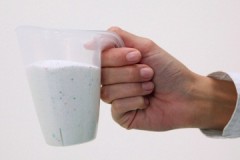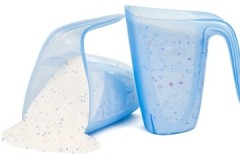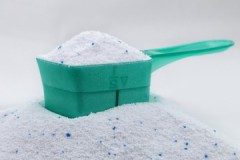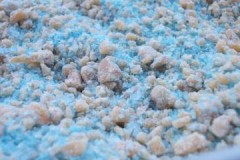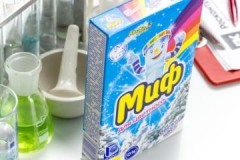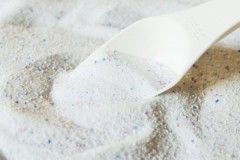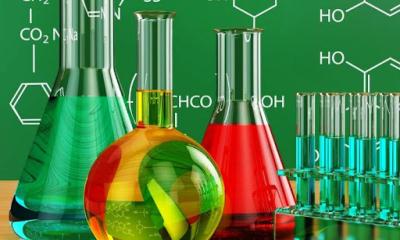 The purchase of a detergent is made taking into account the purpose of the drug and its composition. The quality of processing, the achieved effect and health depend on the correct choice.
The purchase of a detergent is made taking into account the purpose of the drug and its composition. The quality of processing, the achieved effect and health depend on the correct choice.
In this article, we will consider in detail the composition of washing powders, the purpose of each component, its safety or harm to human health and the environment.
Content
- What is the detergent made of?
- The difference between the active ingredients of capsules, powders, gels
- Features of children's washing powders
- Differences in the components "hand wash" and "automatic"
- GOST
- Information given by the manufacturer
- Harmful and harmless substances
- Selection recommendations
- Conclusion
What is the detergent made of?
Most modern washing powders have a complex composition. These are multicomponent mixtures with the entry of a large number of chemicals.
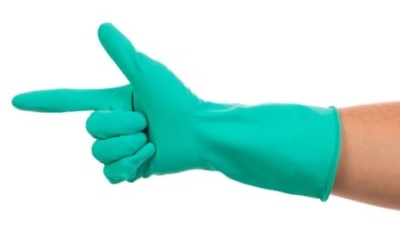 The very composition of manufacturers of household chemicals form taking into account the specifics of the use of the product and its purpose:
The very composition of manufacturers of household chemicals form taking into account the specifics of the use of the product and its purpose:
- By the color of the linen.
- According to safety requirements (for example, the safest composition should be for newborns).
- For automatic / hand washing, etc.
Surfactant
In laundry preparations, surfactants are one of the main components. They are responsible for the efficiency of cleaning dirt and provide an antistatic effect.
Surfactants are subdivided into non-ionic and ionic... Taking into account the standards, the amount of surfactants in powders should be no more than 35%.
Sulphates
Sulfates by themselves are not active ingredients in the washing process. Their task (usually sodium sulfate) is to activate the surfactant, acting as an electrolyte. At the same time, the work of surfactants in the fibers of the material becomes better due to chemical reactions.
Electrolytes and complexing agents
The task of electrolytes is to increase the effectiveness of surfactants. For these purposes, substances are most often used:
- sodium bicarbonate;
- sodium sulfate.
In order to maintain a decent washing result, manufacturers of phosphate-free powders have to increase the proportion of surfactants in this case.
Phosphates
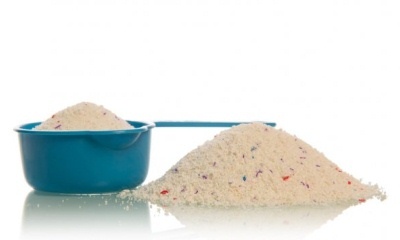 The purpose of phosphate injection is to soften hard tap waterrich in magnesium and calcium. This happens due to a chemical reaction resulting in the binding of ions.
The purpose of phosphate injection is to soften hard tap waterrich in magnesium and calcium. This happens due to a chemical reaction resulting in the binding of ions.
Water softening allows the active components of the powder (surfactant) to act on contaminants more efficiently and give a better processing result.
One alternative is phosphonates... These are substances less harmful than phosphates, which are also used to soften water during washing.
Learn more about phosphates this publication.
Antiresorbents
The task of antiresorbents is to prevent re-settling of already washed contaminants on the fabric. For these purposes, the following ingredients are introduced:
- Carbomethylcellulose.
- Sodium silicate.
The proportion of antiresorbents in the powder should be within 2%.
Enzymes
The inclusion of enzymes in the composition of washing mixtures provides high-quality washing of stains - fats and proteins. This allows you to wash away dirt left by sauces, ice cream, chocolate, etc. from materials.
Will tell you more about enzymes this article.
Bleaches
Bleaches in washing powder:
Optical
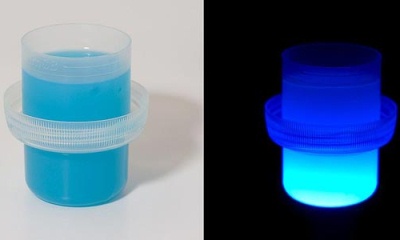 At its core optical brighteners do not lighten the fabric, but create an effect due to the entry of substances that reflect light.
At its core optical brighteners do not lighten the fabric, but create an effect due to the entry of substances that reflect light.
In this case, a film forms on the surface, and the product looks whiter. Such bleaches are dyes and do not participate in the process of removing dirt, as they are only responsible for the visual effect.
Derivatives play the role of active substances:
- stilbene;
- benzimidazole;
- coumarin.
The amount of optical brighteners in the detergent composition can be up to 1%. Learn more about optical brighteners here.
Oxygen
Oxygen bleaches are usually sodium percarbonate. This substance imparts whiteness to clothes and provides disinfection.
This type of bleach is non-toxic., dissolves well in water and rinses out, and removes unpleasant odors.
Peroxide
The action of peroxide bleaches is based on an oxidation reaction. In this case, not only dirt is eliminated, but also disinfection of things is ensured. The content of this type of bleach can be up to 30%.
Flavors
 Fragrances are present in the vast majority of washing powders. They do not affect the quality of washing, but are only responsible for maintaining a pleasant aroma on things.
Fragrances are present in the vast majority of washing powders. They do not affect the quality of washing, but are only responsible for maintaining a pleasant aroma on things.
Flavors can be of two types:
- Natural.
- Synthetic.
To enhance the flavor, phthalates can be added to the composition - a product that is obtained during the oxidation of naphthalene.
Other chemical constituents
In addition to those listed, as part of powders can be used:
- dyes,
- substances that retain the consistency of the product,
- water (in liquid form of powders), etc.
Natural powders are most often based on soap, soda and citric acid.
The difference between the active ingredients of capsules, powders, gels
Different forms of detergents differ in composition, even if they belong to the same manufacturer's line. This is due to the peculiarities of the consistency.
Powders are often more effective at cleaning than gels, and have a richer composition. But they don't rinse out well and can get dusty when used.
The liquid form acts softer, and is suitable for delicate materials, has a lower content, in comparison with the dry form, of surfactants.Gels dissolve well and are evenly distributed in water. After washing, such a substance is well rinsed out. They do not generate dust, which eliminates irritation of the respiratory tract.
Capsules often have multiple chambers. The release of their contents occurs in a specific order.
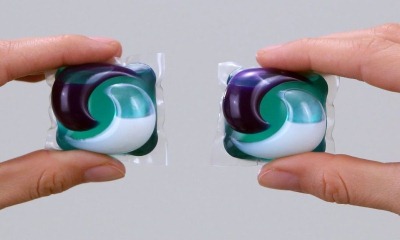 Typically, these formulations contain:
Typically, these formulations contain:
- concentrated washing gel;
- stain remover;
- air conditioning.
This option allows you to carry out a complex automatic washing of linen. But this option is not suitable for manual processing.
Features of children's washing powders
Increased requirements are imposed on the composition of children's powders. Their composition must be safe for babies.... Household chemicals manufacturers produce synthetic and natural products that undergo strict control, starting with the quality of the ingredients used.
Bleach for baby powders should not be optical. This is due to the high allergy of such substances.
One of the best baby powder options is natural, soap-based... The rating of phosphate-free baby powders is presented in given publications.
Differences in the components "hand wash" and "automatic"
Powders for automatic washing differ in composition from preparations for manual processing. Their main feature is less foam formation. For this purpose, defoamers are introduced into them, which allow effective washing with a minimum amount of foam.
Also in the composition of many powders marked "Automatic" are present substances used to prevent limescale deposits on the elements of the machinein contact with water and washing mixture. But not all manufacturers of detergents introduce such an addition. Detailed information can be found on the packaging for the drug.
The introduction of additional ingredients into the composition of powders for automatic processing leads to an increase in the cost of production. He will tell you about the difference between powders for hand washing and an automatic machine this article.
GOST
All detergents are produced in accordance with the standards and agreed norms. One of the main regulatory documents is GOST.
 According to GOST 32479-2013, mandatory for inclusion in the information on the packaging are substances, the occurrence of which is more than 0.2% for the following components:
According to GOST 32479-2013, mandatory for inclusion in the information on the packaging are substances, the occurrence of which is more than 0.2% for the following components:
- Surfactant.
- Phosphates and phosphonates.
- Polycarboxylates.
- Zeolites.
- Soap.
- Oxygenated bleaches.
- Some types of acids and salts.
The manufacturer must indicate the percentage of occurrence of the components, taking into account the range:
- 30% or more;
- from 15 to 30 %%
- from 5 to 15%;
- up to 5%.
Also in the composition the following ingredients must be specified without fail (regardless of mass fraction):
- optical brighteners;
- disinfectant components;
- enzymes;
- preservatives;
- perfume.
Compliance with GOST requirements is mandatory for manufacturers. You can learn more here.
Information given by the manufacturer
World-class manufacturers who value their reputation, as a rule, provide full detailed information on the composition.
They also indicate:
- Your contact information.
- Storage requirements.
- The order of use.
- Appointment.
- Shelf life.
- Manufacturing date.
An example of the comparative characteristics of the compositions of some popular detergents is presented in the table:
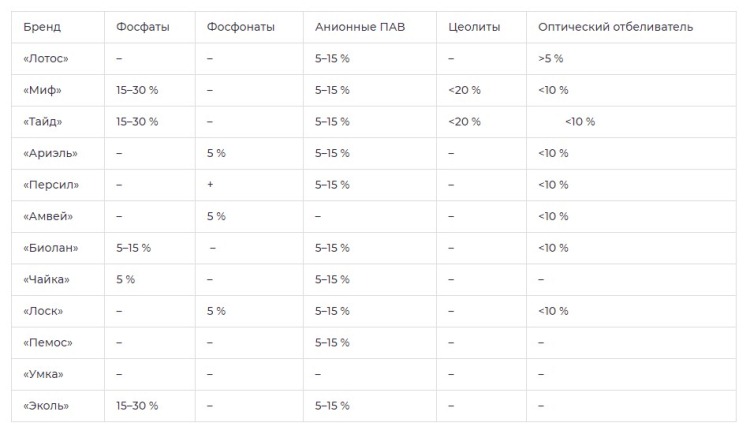
You can trust the information on the packaging for products from well-known manufacturers who value their reputation. The inspection is carried out by the controlling state bodies of the Russian Federation.
Harmful and harmless substances
The composition of almost every detergent is complex and contains a whole list of ingredients. Choosing the safest drug is not an easy task:
| Component | Safety degree | ||
| Safe | Neutral | Dangerous | |
| Chlorine | + | ||
| Sulphates | + | ||
| Optical brighteners | + | ||
| Phthalates | + | ||
| Flavors | + | ||
| Phosphates | + | ||
| APAV | + | ||
| Natural soap | + | ||
| Soda | + | ||
| Lemon acid | + | ||
| Formaldehyde | + | ||
| Parabens | + | ||
| Propylene glycol | + | ||
| Plant extracts | + | ||
| Water | + | ||
| Nonionic surfactants | + | ||
| Oxygen bleach | + | ||
| Enzymes | + | ||
| Antiresorbents | + | ||
| Peroxide bleaches | + | ||
| Silicates | + | ||
| Natural flavor | + | ||
| Dyes | + | ||
When analyzing, it is necessary to take into account not only the fact that the component is included in the composition, but also the percentage in which it is present.
Selection recommendations
When buying a detergent Consider the following:
 The most harmless formulations include those that consist of natural ingredients, have a note about biodegradability, and the possibility of using them for washing clothes of newborns.
The most harmless formulations include those that consist of natural ingredients, have a note about biodegradability, and the possibility of using them for washing clothes of newborns.- A less saturated composition of synthetic powders is less effective at handling dirt and tough stains.
- Hand powder should not be put into the washing machine and capsules should not be used for hand washing.
- The high price of the powder is not a guarantee of the safety of the composition.
He will tell you about what an amplifier of washing powder is and what is included in its composition this publication.
Find all the most useful and interesting about washing powder in this section of the site.
Conclusion
The composition of the washing powder allows us to speak about the degree of its safety and effectiveness due to the analysis of the components. This is especially important when choosing a detergent for children, people with sensitive skin and allergy sufferers.
